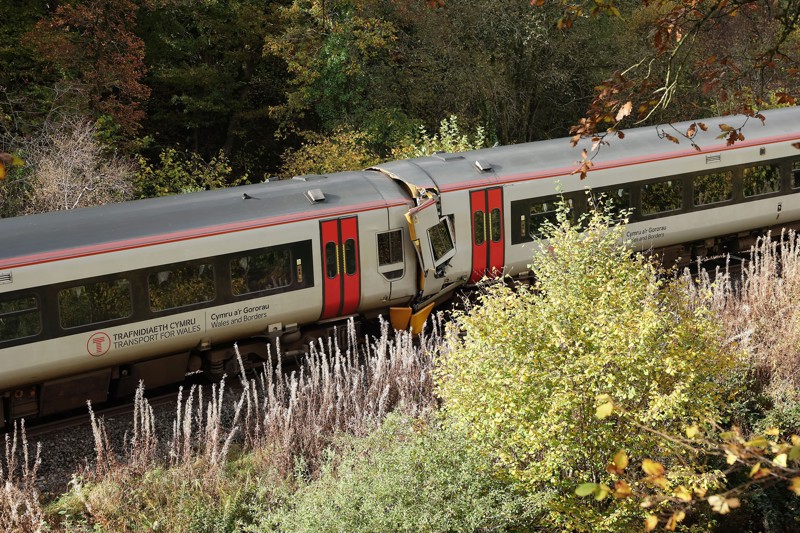
A former Deputy Chief Inspector of Railways has called for magnetic track brakes (MTBs) to be fitted to British main line trains, in the wake of October 21’s collision at Talerddig in Wales.

A former Deputy Chief Inspector of Railways has called for magnetic track brakes (MTBs) to be fitted to British main line trains, in the wake of October 21’s collision at Talerddig in Wales.
Speaking to RAIL, safety expert David Keay said: “Over the years we would have saved quite a number of lives if British trains had been fitted with track brakes.
“Collisions such as Southall in 1997 and the more recent wheelslide incidents at Salisbury and Talerddig could have been avoided if the trains involved had been fitted with emergency track brakes. They should be thoroughly examined for use in the UK.
“MTBs are a high-integrity standalone safety system. Their major advantage is that they provide an emergency brake that is independent of friction - they don’t depend on the railhead, which has been a critical factor in recent collisions.
“The additional costs are not that great, they’re available ‘off the shelf’ from established suppliers such as Knorr-Bremse, and they’re covered by an existing TSI [Technical Standard of Interoperability]. They are reasonably practicable to fit - especially on a standardised train platform such as the Stadler FLIRT, which is designed to have them.”
MTBs can be attached to the bogie frames of locomotives, to multiple units, and to coaching stock. When electrical current flows through a magnet coil, the magnet is attracted to the rail, clamping against the rails and decelerating the vehicle rapidly when applied in emergency situations.
While disc brakes or traditional tread brakes depend on creating friction directly onto the wheelsets, MTBs act directly on the rail. As a result, their effectiveness is not limited by wheel-rail contact, and environmental factors such as contamination of the rail and moisture have less influence on deceleration.
A secondary benefit of MTBs is that they increase adhesion between the following wheels and the rail during the braking process, which allows the primary brake systems to work more effectively after deployment of the emergency brakes.
They have been in widespread use since the 1930s, but despite their proven efficacy they have never been adopted for UK main line use. And there remains a reluctance from some sections of the rail industry to introduce them.
“I get the impression that it’s a case of ‘not invented here’ in some quarters,” explained Keay.

“There’s a scepticism, particularly on the infrastructure side, about their effectiveness and their potential for damaging rails or interfering with signalling equipment.
“A track brake will not interfere with a track circuit the vehicle is occupying, since axles short across the rails and I cannot see a mechanism where they would interfere with axle counters. Clearly it all needs to be tested under many conditions, but why have they not started, or indeed spoken to existing users?”
Network Rail Engineering Director Martin Frobisher told RAIL: “I don’t think we have any objection to the principle. Quite the opposite, we would see the performance and safety benefit during autumn.
“We would just need to make sure that it’s properly engineered. There is obviously the potentially for this technology to create stray currents in signalling circuits or radio interference.”
The electromagnets in MTBs remain inert until activated by the driver making an emergency brake application, so electromagnetic (EM) emissions should be limited to situations where there is an imminent threat of collision.
MTBs are mandatory for passenger trains in Germany, Switzerland and Austria (among others), and have been mandatory in the UK for on-street running since 1906.
All current British light rail and tram vehicles are fitted with MTBs, including Sheffield Supertram’s Class 399s and the new Transport for Wales Class 398 tram-trains for South Wales Metro. However, the Class 398/399s are not permitted to use their emergency MTBs when running on Network Rail tracks.
In 2016, the Rail Safety and Standards Board (RSSB) investigated MTBs and endorsed the development of a Railway Group Standard to enable their introduction in Britain.
The research project did not identify any significant technical incompatibilities between MTB-equipped rolling stock and Network Rail infrastructure that cannot be mitigated. It also identified that an economic case exists for full-fleet fitting of MTBs as standard on all new rolling stock builds, although this is yet to occur.
Testing of light rail vehicles for the Nottingham and West Midlands Metro systems included extensive checks for EM interference from systems such as magnetic track brakes before the trams were permitted to run close to Network Rail infrastructure.
In Nottingham and Birmingham, trams run just a couple of metres from NR tracks without any detrimental effect on adjacent systems.
Login to continue reading
Or register with RAIL to keep up-to-date with the latest news, insight and opinion.


















Derek Amitri - 08/01/2025 08:26
Alternatively, properly manage lineside vegetation.